“In an increasingly interdependent world, economic shocks in one region can quickly spread to others. Recently announced measures to reinforce the euro and boost growth in the United States are therefore extremely welcome,” said WTO Director-General Pascal Lamy.
“But more needs to be done. We need a renewed commitment to revitalize the multilateral trading system which can restore economic certainty at a time when it is badly needed. The last thing the world economy needs right now is the threat of rising protectionism,” he said.
The global economy has encountered increasingly strong headwinds since the last WTO Secretariat forecast was issued in April. Output and employment data in the United States have continued to disappoint, while purchasing managers’ indices and industrial production figures in China point to slower growth in the world’s largest exporter.
More importantly, the European sovereign debt crisis has not abated, making fiscal adjustment in the peripheral euro area economies more painful and stoking volatility. Figures for world trade include trade between EU countries (i.e. EU intra-trade), making them highly sensitive to developments in this region.
All of these factors have contributed to an easing of global trade growth, which slowed to a crawl in the second quarter according to new quarterly merchandise trade volume statistics compiled by the WTO (Chart 1 and box).
Chart 1 — World merchandise trade volume, 2005Q1-2013Q4
Seasonally adjusted index, 2005Q1=100
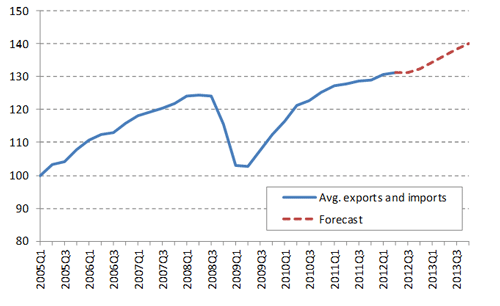
Source: WTO Secretariat.
The volume of world trade as measured by the average of exports and imports only managed to grow 0.3% in the second quarter compared to the first, or 1.2% at an annualized rate.
The trade slowdown in the first half of 2012 was driven by an even stronger deceleration in imports of developed countries and by a corresponding weakness in the exports of developing economies, which for the purposes of this analysis includes the Commonwealth of Independent States (Table 1).
The WTO now expects world merchandise trade volume to grow by 2.5% in 2012 (down from 3.7% in April). On the export side, we anticipate a 1.5% increase in developed economies’ trade (down from 2%) and a 3.5% expansion for developing countries (down from 5.6%). On the import side, we foresee nearly stagnant growth of 0.4% in developed economies (down sharply from 1.9%) and a more robust 5.4% increase in developing countries (down from 6.2%).
Table 1 — World merchandise trade and GDP, 2008-2013 a
Annual % change
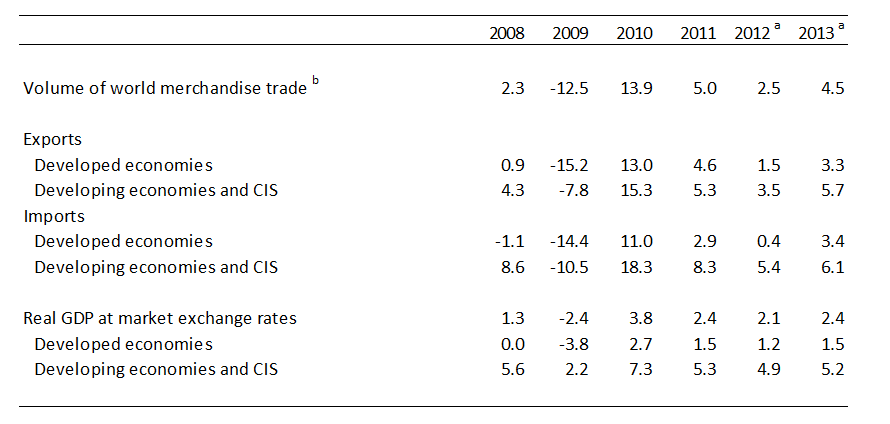
a Figures for 2012 and 2013 are projections.
b Average of exports and imports.
Source: WTO Secretariat for trade, concensus estimates of economic forecasters for GDP.
Figures for 2013 are provisional estimates based on strong assumptions about medium-term economic developments, including:
- that current policy measures will be sufficient to avert a breakup of the euro, and
- an agreement will be reached to stabilize public finances in the United States, thereby avoiding automatic spending cuts and tax increases early next year.
Failure of these and other assumptions could derail the latest projections.
As a result, these figures should be interpreted with caution. Based on current information, the WTO expects trade growth to rebound to 4.5% in 2013. Exports of developed and developing economies should increase by 3.3% and 5.7%, respectively, while imports of developed and developing countries should advance 3.4% and 6.1%.
Although developed countries collectively recorded modest increases in both exports and importsin2012, some grew faster than others. Chart 2 shows seasonally adjusted quarterly trade volume indices for the largest developed economies since the beginning of 2010.Exports of the United States and shipments from the EU to the rest of the world (i.e. extra-EU exports) grew steadily over the past year, with year-on-year increases of around 7% and 5%, respectively, in the second quarter.
Japanese exports have been mostly flat since mid-2010, but even they recorded an 8.5% year-on-year increase in the second quarter. Imports of the United States and Japan have also held up relatively well despite the crisis, with year-on-year growth of roughly 5% and 6% in the latest period.
However, import demand in the European Union has weakened significantly, resulting in less tradebetween EU countries (intra-trade down3.5% year-on-year in the second quarter) and fewer imports from the rest of the world (also down 3.5%). The weight of the EU in total world trade (around 35% on both the export and import sides in 2011, including EU-intra trade), combined with the larger-than-expected year-on-year drop in EU imports through the first half of 2012, explains much of the downward revision to the forecast. The EU also represents nearly 60% of developed economies’ imports, which accounts for the stagnation in projected imports of developed economies in 2012.
Chart 2 — Merchandise trade of major developed
economies, 2010Q1-2012Q2
Seasonally adjusted volume indices, 2010Q1=100
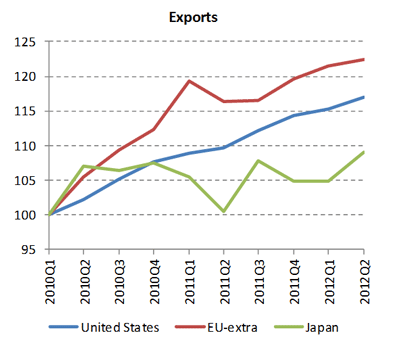
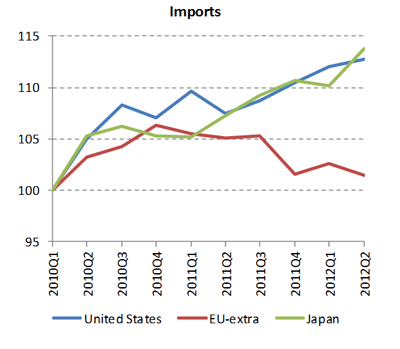
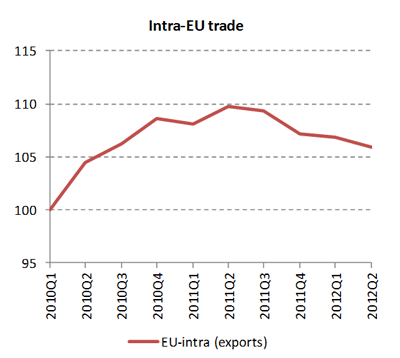
Weak import demand in developed countries and softer domestic demand in China have contributed to sagging trade flows in the developing world, most noticeably in dynamic export-oriented economies in Asia.
Chart 3 shows year-on-year growth in China’s merchandise trade flows in volume terms (not seasonally adjusted), which have declined steadily over the last two and a half years. Export growth dropped to 2.9% and import growth fell to 2.8% in the first quarter of 2012 before rebounding slightly in the second quarter, but available monthly data suggest that the third quarter results may be weaker still.
Chart 3 — Merchandise exports and imports of China, 2010Q1-2012Q2
(year-over-year % change in volume, not seasonally adjusted)
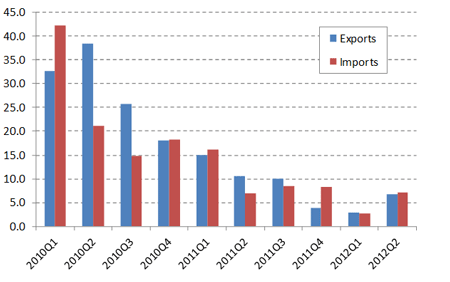
Source: WTO Secretariat.
Chart 4 shows year-on-year growth in monthly merchandise exports and imports for selected economies in current dollar terms, including partial data for the third quarter. Those economies that have already reported figures for August show either stagnation (e.g. China) or decline (e.g. Brazil, Japan, Singapore), which suggests that that the recent weakness of trade will persist into the third quarter.
Risks to the forecast will remain mostly on the downside as long as financial uncertainty in Europe remains elevated. Other events could also intrude to produce worse outcomes for trade, including a “hard landing” for the Chinese economy or geopolitical tensions. However, there is also some upside potential if the European Central Bank’s recently announced bond purchasing program has an immediate salutary effect on EU import demand.
In this case we might see slightly faster growth in the fourth quarter and for 2012 as a whole, but possibly less growth in 2013 as the reversion to recent trends would be weaker. The growth of world trade observed in the first half of 2012 is less than what traditional econometric models would predict given current rates of growth in gross domestic product (GDP).
This also occurred during the trade collapse of 2008–09 that accompanied the global financial crisis and may be related to issues such as access to trade finance or, in the case of the sovereign debt crisis, the re-introduction of exchange rate risk into peripheral euro area economies.
> Download this press release (pdf format, 7 pages, 110KB)
NEW: QUARTERLY VOLUME DATA
The WTO’s short-term trade statistics now include quarterly merchandise trade growth in volume (or real) terms. This is a new addition to the WTO’s quarterly trade data, which were previously only available as values in current dollar terms.
Trade value data do not take inflation and exchange rate changes into account, whereas volume figures do. This can be useful when looking at changes over a period.
This new dataset, which includes both seasonally adjusted and non-seasonally adjusted series for selected countries and regions, has been prepared using methods devised in co-operation with the UN Conference on Trade and Development (UNCTAD).
Go to www.wto.org/statistics and look for “Short-term Trade Statistics” or go directly to: Short-term Trade Statistics
(Q1, Q2, Q3, Q4 = first, second, third and fourth quarters)
> Problems viewing this page?
Please contact [email protected] giving details of the operating system and web browser you are using.
Chart 4 — Merchandise exports and imports of selected economeis,
January 2011-August 2012
(Year-on-year % change in current dollar values)
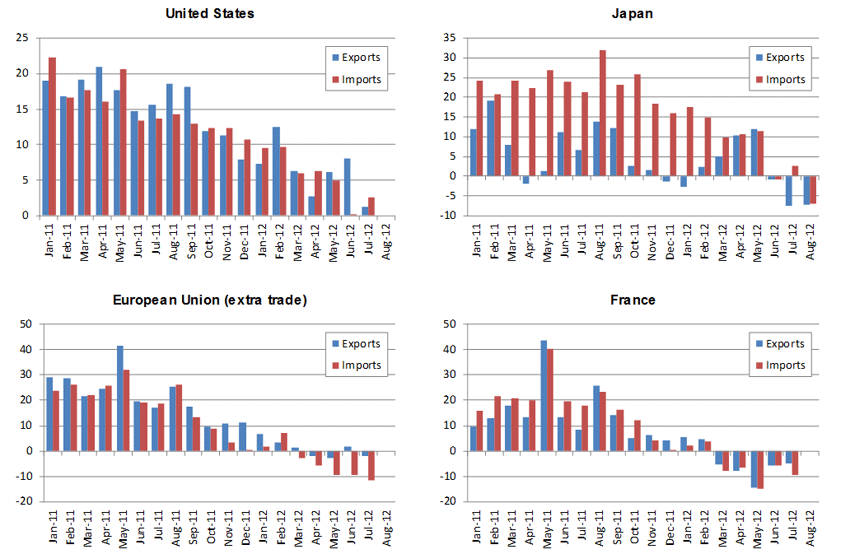
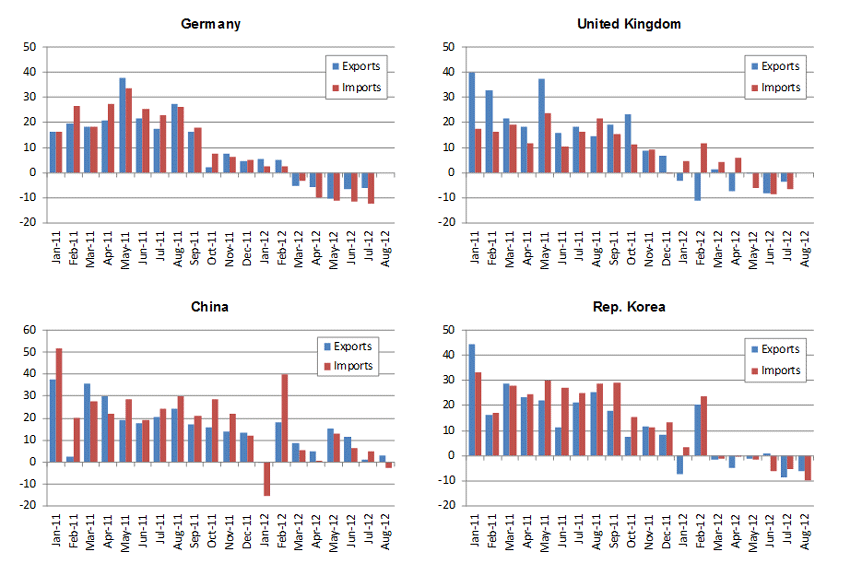
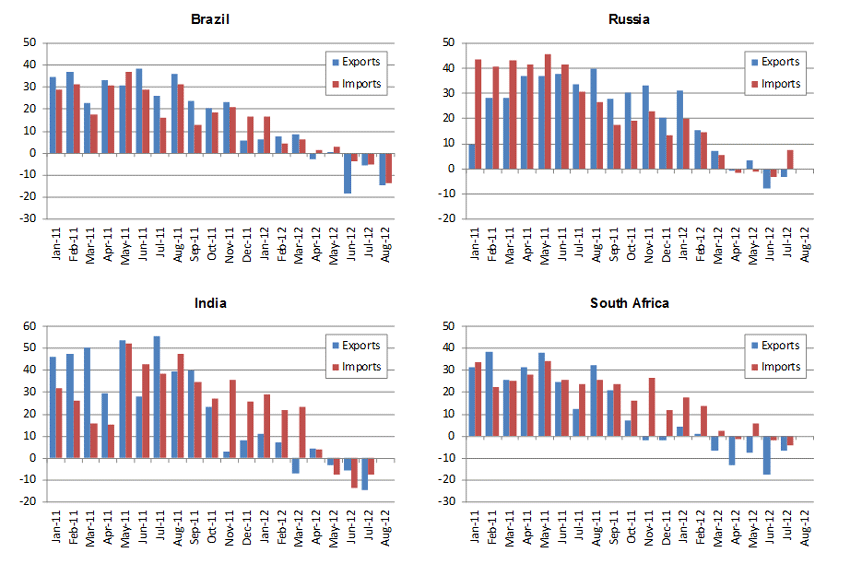
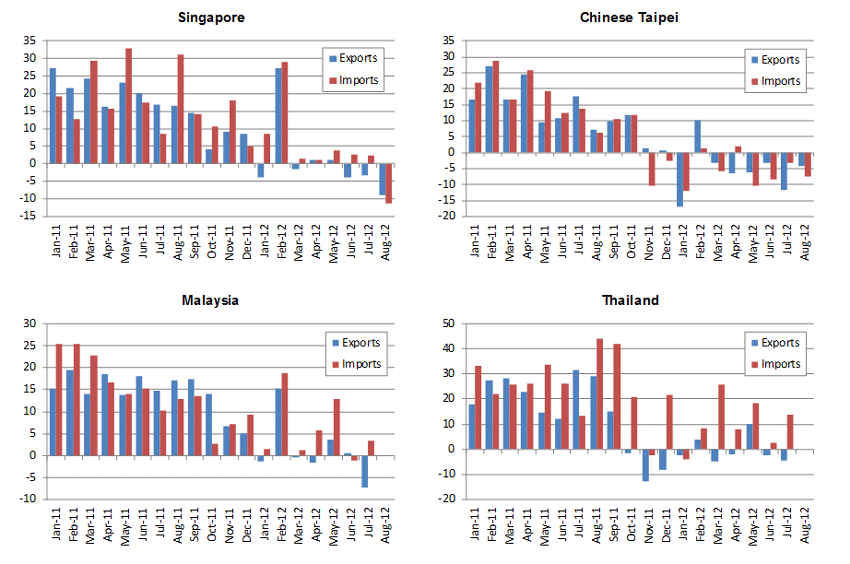
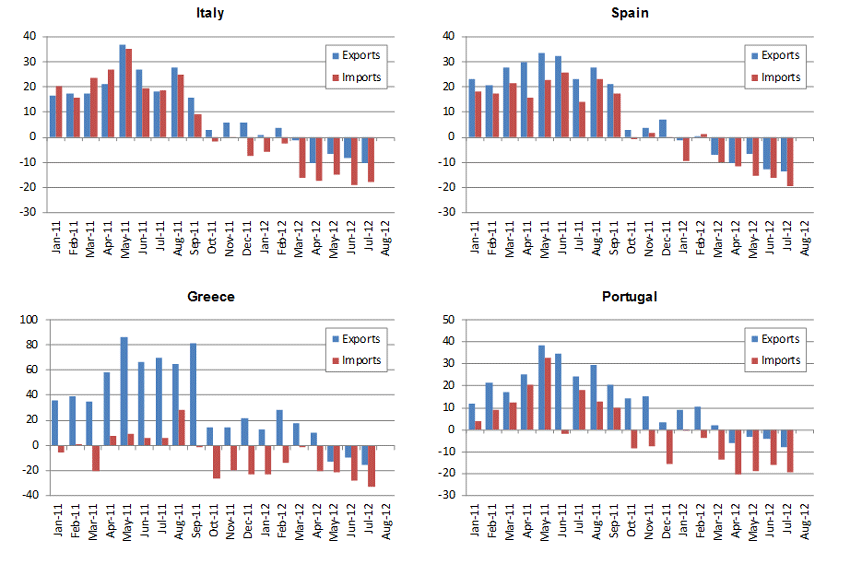
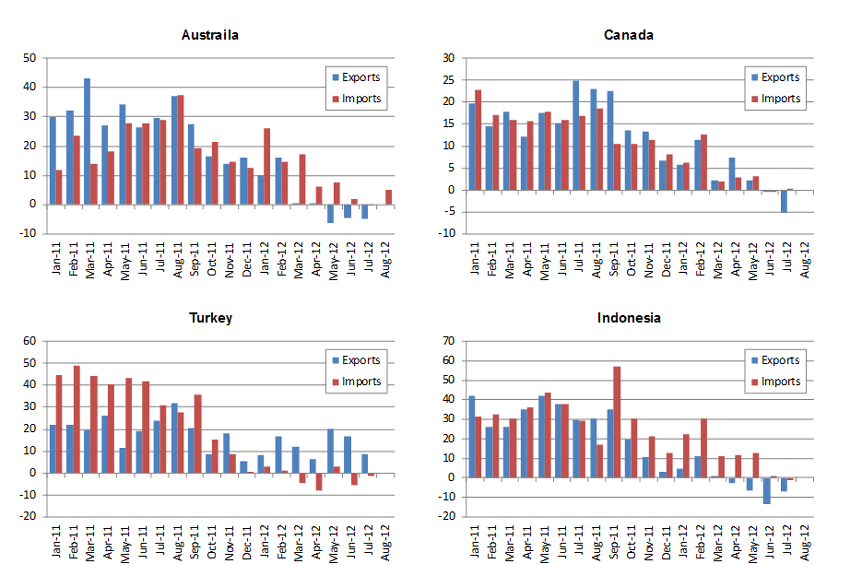
Sources: IMF International Financial Statistics, Global Trade Information Services GTA database, national statistics.
